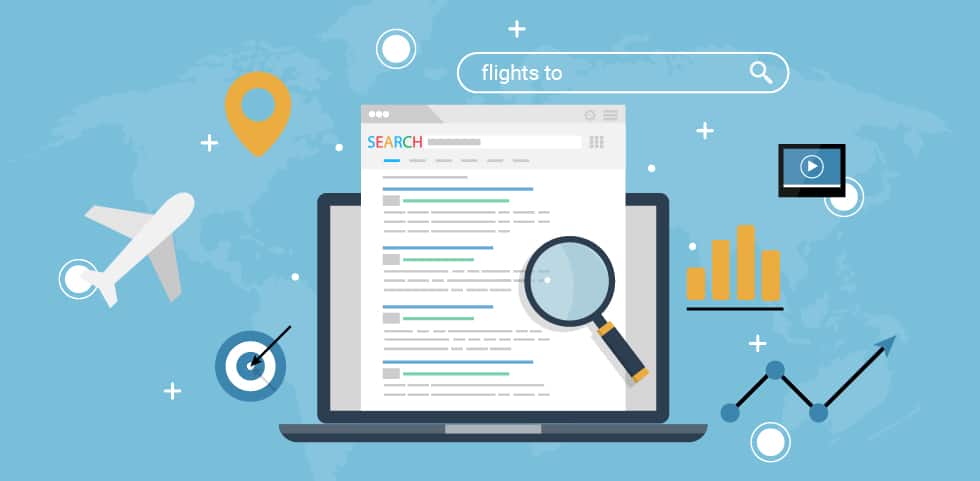During the pandemic, airlines have had to reduce their route networks and cut costs to make up for reduced revenue. These cost cuts have extended across SEM budgets. A byproduct of this is that it has enabled OTAs to bid for airline keywords in paid search, raising rankings and driving traffic to OTAs who are able to then sell the airline tickets for available routes.
Is this a winning strategy to save money? Not when you explore deeper. Airlines will likely end up paying a higher Cost of Sale (CoS) percentage through those OTA sales as compared to what could be achievable by investing in SEM. Not only are airlines paying more, they are also missing out on cultivating customer loyalty and selling ancillaries, which should be prioritized during this time of reduced sales. Even worse, surrendering potential customers to OTAs risks their booking going to a completely different airline.
Investing in SEM Means More Revenue
Paid search offers airlines an opportunity for immediate cash flow generation. Paid search ads can help airlines to capture high-intent demand. By initiating a search, the user is proactively proving their demand for the route they want to fly. Airlines don’t need to invest in inspiration or other marketing tactics to guess what users are looking for. If someone searches for a route that an airline is bidding on, they will see that airline’s ad and the airline will pay for a highly qualified click.
SEM, when managed with discipline, can realize a CoS of 1-3% for revenue generated. By contrast, OTA cost of sale for an airline can exceed 6% of each sale. By keeping SEM ads active for available routes with low load factors, airlines have the opportunity to earn more revenue from every sale. In contrast, turning off SEM risks costing the airline more revenue than it will save in SEM fees if that booking is instead fulfilled by the OTA.
Why are you letting the OTA sell your flights?
Some airlines make the mistake of concluding that because traveler interest is low, they should reduce their advertising. We find the opposite to be true. Even though the load factor is low, there are still flights taking off, so why not prioritize getting as much revenue as possible from the ticket sales that are currently happening? If airlines go along with this strategy they will not only end up paying higher CoS to OTAs, but also will enable OTAs to arbitrage the traffic and control the airline’s market sales.
Incrementality of a sale right now is much, much higher than in the past, and will remain so for a while. That means the airline must assess the variable cost of a passenger; comparing the fixed costs of putting a plane in the air to the true gross profit of each passenger that buys a flight.
Reduced Revenue and Lost Loyalty
After a crisis, previously loyal customers will not be as dependable as they once were. Many do not have the same travel demands as before, corporate travel will be reduced, and OTAs will be even more aggressive in their attempts to acquire customers – particularly in an environment where airlines have dramatically reduced SEM spending.
If an airline surrenders their paid search keywords to be dominated by OTAs, there can lasting effects on brand loyalty. When customers search for “Flights to…” a destination, and consistently find OTAs at the top of search results, some will determine that OTAs are the first place to look for flights. Regardless of what carrier the customer chooses when they complete their purchase, the brand that they are associating the experience with is the OTA, not the airline.
How can airlines win?
Airlines can use this as an opportunity to reclaim customers from OTAs by offering competitive fares and marketing them for the main keywords in paid search. Airlines can also help reactivate loyalty with competitive points/miles redemption through attractive deals. With paid search, airlines can pay less for each transaction, drive traffic to their website, and build relationships with travelers.
Airlines can also use the data that they have available to make decisions, based on parameters such as demand, load factor, and Google queries, in order to start earning revenue via SEM. Combining this data and involving different departments with the same goal, will bring the best result and ROI. For example, if the airlines have a best practice to cross-share the data, based on their main KPIs, the SEM marketer can make smart and efficient decisions. At this moment the best you can do is to focus on the markets and routes that have some sign on demand and cross that information with the internal load factor and flights available in order to advertise the correct routes at the perfect time, which will increase direct bookings.
Preparing to Scale Post-COVID
Once the COVID-19 crisis ends and search volume surges, past competitors will return to auction and existing competitors will increase their bids. Many OTAs and Meta Search Sites have not stopped their SEM efforts during COVID-19 and are prepared for the competitive landscape that will form during the Recovery Phase.
By investing in SEM throughout the crisis, airlines can attract more customers and revenue now, while better positioning themselves for recovery post-Covid. EveryMundo offers several airline-specific SEM tools to scale SEM efforts for the best return possible.
Our primary SEM product, airSEM, is a suite of tools developed for airlines to best create, manage, and optimize their SEM campaigns. When paired with our Fare Marketing platform, airTRFX, airlines can drive traffic from their SEM clicks directly to high-performance landing pages with real-time fares to provide the best user experience and increase conversions from their SEM channel. With minimal IT involvement and only a few weeks to launch, EveryMundo products can greatly improve SEM channel performance for airlines so that they can achieve greater revenue now and as they scale back up in the future.

